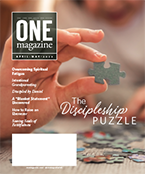
April-May 2023
The Discipleship Puzzle
------------------
|





REFRESH | Multi-Ethnic Ministry in the Local Church
By Marshall Bonéy
One of the most wonderful aspects of spring is the anticipation of everything coming back to life—the reappearance of many varieties of foliage and vibrantly colored flowers. The colors of spring also serve as a reminder of how much I anticipate Heaven, where all the diverse hues and ethnicities of humanity will unite to worship God. Our Heavenly Father adores the magnificence of variety. In Heaven, we see a mosaic of people from every country, tribe, people group, and language congregating to worship around God’s throne (Revelation 7:9-12).
It’s a good reminder that our world is not black and white, but an amazing kaleidoscope of colors. We have an urgent need for all races to find the unity Jesus preached to and even prayed over His disciples (John 17:20-21). Jesus established His Kingdom from a multicolored array of people transformed by the power of the gospel (Revelation 5:9-12). This is not to suggest every church is mandated to be multi-ethnic. This often depends on the geographic location and surrounding community. For example, a church in Idaho or Mexico should look like the people in the area surrounding the church.
Still, the church should communicate the diversity of the gospel. I love what we see happen in the church in Acts 11, when Peter made it clear the gospel was intended for all people, not only the Jews. The church in Antioch, especially, personifies the movement of the gospel toward diversity (Acts 11:19-21).
With these things in mind, consider this sad reality: only 13.7% of churches in North America are multiethnic. That means 86.3% of churches are homogeneous. Even more troubling: churches are ten times more segregated than the neighborhoods around them and 20 times more segregated than nearby schools. Even fewer churches have multi-ethnic leaders. These statistics might cause some to wonder about the potential of today’s church. How are we going reach everyone for Christ? Going forward, we must consider the demographics of our communities.
Advanced strategic planning is more effective when the pastor understands the demographics of his city or town. Statistically, what is the percentage of the religious population (Catholics, Baptists, Non-denominational, Free Will Baptists, etc.)? What are the demographics in terms of race, income, education level, and more? This information enables the pastor to identify potential visitors and reach out to the community more effectively.
The cost of reaching out to all demographics can be challenging, even difficult. However, the Word of God instructs us to conform to the image of Christ, not to be comfortable in His image. This implies individual preferences must yield to the larger mission of the Christian community. I’ve discovered the reflection of God’s beauty shines in everything, and humanity is no exception (Psalm 50:1-2). To recognize His beauty in whatever we do, love must serve as the filter through which all ministry flows (John 13:34-35). Preach, evangelize, and confront with the motivation of love.
When building a multi-ethnic church, outreach gets people excited. However, outreach cannot be random but should be proportional to correctly-identified needs of the community. For instance, effectiveness considers available resources. Does the area have an unusually high number of laundromats? Perhaps raising funds for “free laundry” is necessary to assist in meeting an important need. Outreach may look different in affluent communities. Perhaps a church could host a community Easter festival. Once again, ministry satisfies a need.
In his book Building a Healthy Multi-Ethnic Church, Mark Deymaz points to the Great Commission in Matthew 28:19-20 and challenges readers to consider evangelism as cross-cultural. Whether a church planter or the pastor of a long-established church, approach the situation with the ultimate goal in mind; consider the demographics, needs, and challenges; and act appropriately.
Within a multi-ethnic society, ministry leaders must consider minority opinions, which may be difficult. Diversity must be intentional when assigning leadership roles, displaying images on websites, or even choosing worship styles. For example, if southern gospel music is preferred, consider whether it relates to all. People who visit the church should be able to say, “I was greeted with open arms here.”
The nations have come to our doorstep, and the diversity that surrounds us will only increase. As a result, the time to prepare for the mosaic of worship in Heaven has arrived. Let us do our part to celebrate and share God’s gospel for everyone.
About the Guest Writer: Marshall Bonéy is the founding pastor of ReIGNITE Church in Virginia Beach, Virginia. Bonéy retired from the U.S. Navy after 22 years of service. He earned a bachelor’s degree in Christian Ministry at Welch College and Regent University and later completed a Master of Divinity and Doctorate in Ministry Leadership and Coaching from Regent Seminary.
About the Columnist: Dr. Brad Ransom is director of church planting and chief training officer for North American Ministries. Contact Brad: brad@nafwb.org.
|
|

